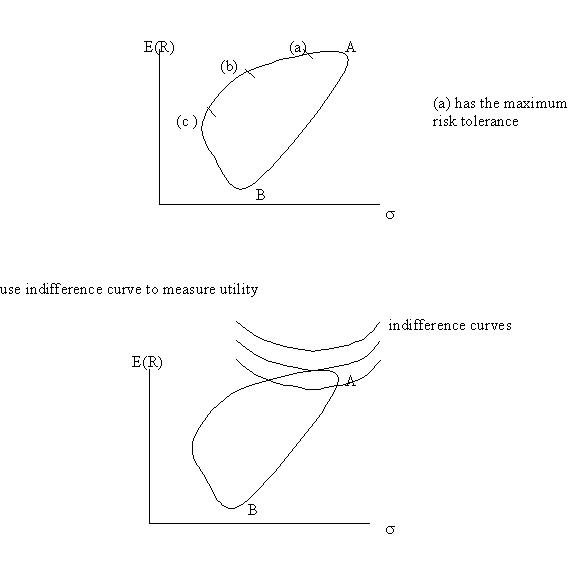Portfolio Theory
![]() Selection of securities
that maximize expected return subject to a level of risk which is acceptable
to an investor
Selection of securities
that maximize expected return subject to a level of risk which is acceptable
to an investor
![]() Capital Market Theory (CAPM)
Capital Market Theory (CAPM)
![]() Theoretical relationship
between risk and return
Theoretical relationship
between risk and return
I
Measuring investment return
V1 – V2 + D
Rp = ----------------
V0
Where V1 : portfolio MV of the end of the interval
Where V0 : portfolio MV of the beginning of the interval
Where D : Cash distribution during the interval
II
Risky Assets and Risk Free Assets
![]() Future return that will
be realized is uncertain
Future return that will
be realized is uncertain
![]() Risk Free asset (riskless)
Risk Free asset (riskless)
![]() Short term obligation of
US government
Short term obligation of
US government
III
Measuring Portfolio returns and risk
1. Expected portfolio return (mean) – Expected mean
![]() Quantify the uncertainty
about the portfolio return
Quantify the uncertainty
about the portfolio return
![]() Specify the probability
associated with each of possible future returns
Specify the probability
associated with each of possible future returns
Note : Sum of probabilities
= 1
![]() Given this probability
distribution, we can measure the expected return
Given this probability
distribution, we can measure the expected return

2. Variability of E(Rp)
![]() measure risk by the
dispersion of the possible returns
measure risk by the
dispersion of the possible returns
![]() measure : variance
or standard deviation (weighted sum of the squared deviation from E(Rp)
)
measure : variance
or standard deviation (weighted sum of the squared deviation from E(Rp)
)



IV
Diversification
![]() combining stocks into a
portfolio to reduce the variance of the returns on your portfolio
combining stocks into a
portfolio to reduce the variance of the returns on your portfolio
![]() while holding returns constant,
reduce risk by adding more securities
while holding returns constant,
reduce risk by adding more securities
Total Risk
1. Systematic Risk (nondiversifiable risk)
![]() risk that cannot
be eliminated by portfolio combination (market related risk) proxy : S&P
500
risk that cannot
be eliminated by portfolio combination (market related risk) proxy : S&P
500
2. Unsystematic Risk (diversifiable risk)
![]() much of the total
risk of individual security is diversifiable
much of the total
risk of individual security is diversifiable
![]() unique to the security
unique to the security
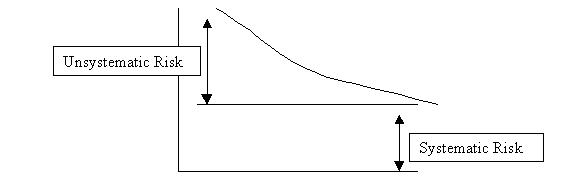
(a) Diversification results from combining securities whose returns
are less than perfectly correlated in order to reduce portfolio
risk
![]() less correlation
--- greater diversification --- risk reduced
less correlation
--- greater diversification --- risk reduced
(b) well diversified portfolio basically carry market risk only.
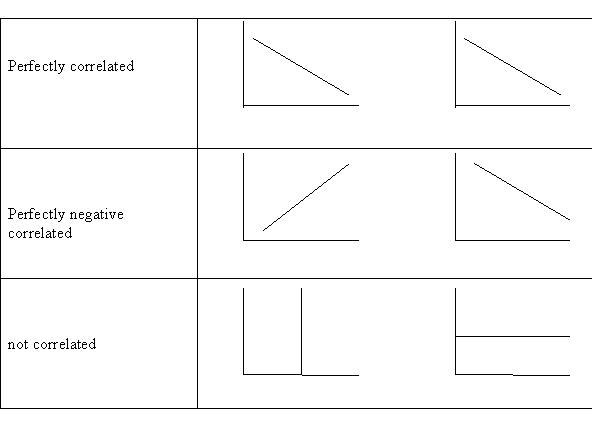
covariance = how well they move together
correlated may measure linear
cov (x,y) = P1(X1 – E(X))(Y1 - E(Y))
= P2(X2 – E(X))(Y2
- E(Y))
if cov (X,Y) = 1000
cov (W,Z) = 500
can’t compare the covariance directly from the number

Correlation {-1, 0, +}
p = 1 : perfectly correlated (positively)
p = 0 : not correlated
p = -1 : perfectly negatively correlated


EXAMPLE
Portfolio choice
![]() 3 state of the world (a,
b, c)
3 state of the world (a,
b, c)
![]() two securities (x, y)
two securities (x, y)
| State | A | B | C |
| Probability | 0.25 | 0.5 | 0.25 |
| x | 20% | 10% | 0% |
| y | -5% | 10% | 25% |
(A)
Expected Return of X and Y
E(X) = 0.25(20) + 0.5(10) + 0.25(10)
= 10%
E(Y) = 0.25(-5) + 0.5(10) + 0.25(25)
= 10%
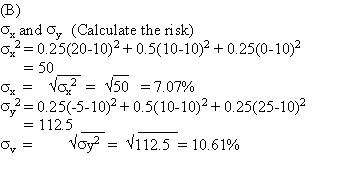
(C )
Portfolio XY formed of one share of X and one share of Y
E(XY) = E(Rp)
= 0.5(10) + 0.5(10)
= 10%


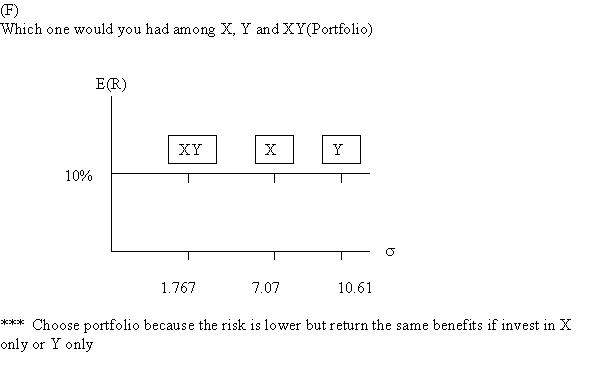
V
Portfolio Theory
![]() Construction of portfolio
that have the highest expected return at a given level of risk
Construction of portfolio
that have the highest expected return at a given level of risk
![]() Mean (return) – variance
(risk) efficient portfolio --- Markowitz Efficient portfolio
Mean (return) – variance
(risk) efficient portfolio --- Markowitz Efficient portfolio
![]() Assumption
Assumption
(a) only 2 parameter affect an investor’s decision(mean a variance)
(b) variance are risk averse
(c) investor seek to achieve the highest E(R) at a given level of risk.


![]() Between point 2 and 4,
choose 4 since it return better benefits at the same risks
Between point 2 and 4,
choose 4 since it return better benefits at the same risks
![]() Point 5 is not real because
beyond the efficient frontier
Point 5 is not real because
beyond the efficient frontier
![]() Investor choose any portfolio
along the blue line (efficient frontier) that starts from MVP to the tip
of the A
Investor choose any portfolio
along the blue line (efficient frontier) that starts from MVP to the tip
of the A
2. Choosing a portfolio in the Markowitz efficient set
![]() investors want to hold
one of the portfolio on Markowitz efficient frontier (MEF)
investors want to hold
one of the portfolio on Markowitz efficient frontier (MEF)
![]() portfolio on MEF ---
trade offs in term of risk and return
portfolio on MEF ---
trade offs in term of risk and return
![]() Optimal portfolio --- depends
on investor’s preference or utility (given investor’s tolerance to risk)
Optimal portfolio --- depends
on investor’s preference or utility (given investor’s tolerance to risk)
